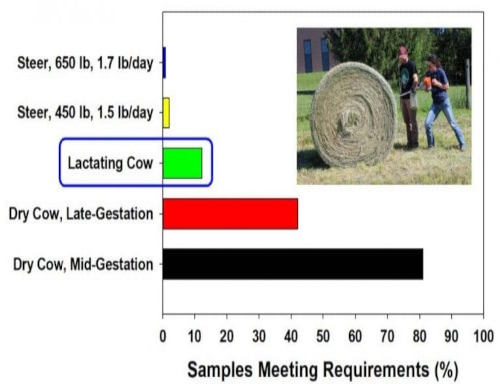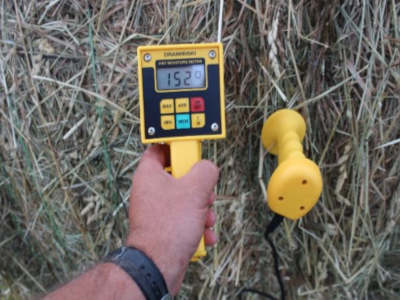By Chris Teutsch
Recently I presented a summary of ten years of hay testing results from the Kentucky Department of Agriculture’s forage testing program. This sample set included more than 14,000 hay samples. The full presentation can be viewed on the KY Forages YouTube Channel.

Figure 1. Proportion of hay samples tested at the Kentucky Department of Agriculture over a ten-year period (2007-17) that would meet the energy (total digestible nutrients) requirement of various classes of beef cattle. Only 12% of these samples would meet the energy requirements of a lactating brood cow!\
The results of this analysis showed that only 12% of the samples tested would meet the energy requirements of a lactating brood cow (Figure 1). This is an important finding for a cow-calf state like Kentucky since reproductive efficiency is so closely associated with body condition.
Practical Considerations for Improving Hay Quality
Grazing is the most economical way to harvest forage and we should strive to extend our grazing season. Our ag economists tell us that about 300 days of grazing is the sweet spot in terms of profitability for most cow-calf operations in the state. This leaves us with 2 to 3 months that we need to feed hay. To optimize reproductive efficiency, it is essential that hay fed will maintain adequate condition on cows OR that poor quality hay is supplemented appropriately. Although hay season seems like a longtime away, it will be sooner than you think. So, 2021 brings us yet another chance to improve hay quality. Below you will find a list of practical considerations that will help you get this done.
- Fertilize and lime according to soil test. A balanced fertility program is essential for optimizing hay production. Phosphorus, potassium, and lime should be applied according to soil test results. Avoid using “complete” fertilizers such as 10-10-10. In hay production, these fertilizers commonly over apply phosphorus and under apply potash. More information on soil sampling can be found in AGR-252, Soil Sampling Hayfields and Pastures.
- Apply nitrogen early to promote rapid spring growth. Applying 80 lb N/A in mid- to late March will promote early growth in hay meadows, resulting in higher first harvest yields.
- Harvest at the boot stage. The single most important factor impacting forage quality is stage of maturity at harvest. Hayfields should be mowed as soon as the grass reaches the boot-stage. By making the first cutting in a timely manner, we will have time to make a leafy second cutting just prior to the summer months.
Table 1. Impact of stage of maturity on the crude protein, dry matter intake, digestibility and average daily gain of stocker calves.
Stage of Maturity
| Stage of Maturity | Crude Protein | Dry Matter Intake | Digestibility | Average Daily Gain |
| | % | lb/day | % | lb/day |
| Late boot | 13.8 | 13.0 | 68 | 1.39 |
| Early bloom | 10.2 | 11.7 | 66 | 0.97 |
| Seed forming | 7.6 | 8.6 | 56 | 0.42 |
Adapted from AGR-62, Quality Hay Production by G.D. Lacefield, J.C. Henning, M. Collins and L. Swetnam. UK Cooperative Extension Service, Lexington.
- Mow early in day. Some studies have shown that sugars tend to highest in late afternoon,making this the optimal time of day to cut. However, in high rainfall environment like Kentucky, maximizing curing time is the highest priority. Therefore, hay should bemowed in mid to late morning after the dew has dried off.
- Use mower-conditioner. Conditioning the stems allows for moisture to escape at a fasterrate. This shortens curing time and improves your chances of avoiding rain.Conditioning is especially important on first cutting grasses, summer annual grasses, andlegumes, all of which tend to have larger stems.
- Set swath on mower-conditioner to the widest possible setting. Maximizing the swath width decreases curing or wilting time by exposing a larger portion of the forage to direct sunlight.
- Rake or ted at 40-50% moisture content. Raking and tedding the forage while it is still pliable helps to reduce leaf loss and maintain forage quality. Once the moisture content is below 40%, leaf loss increases, especially in legumes such as alfalfa and clover.
- Bale at 18-20% moisture. Baling in this moisture range inhibits mold growth and reduces heating. Avoid baling hay that is excessively dry due to high levels of leaf loss and hay that is above 20% moisture due to heating and potential hay fires.

Figure 2. This hay was baled above the 18-20% moisture range and has reached an internal temperature of more than 150 degrees Fahrenheit. Heating damages protein making it unavailable to the animal. If stored in a tightly packed hay barn, this bale could start a hay fire.
- Store under cover and off the ground. Protecting hay from weathering helps to reduce dry matter losses and maintain forage quality. Much of the weathering damage is a result of the hay bale wicking moisture up from the ground. So, storing hay off the ground on a stone pad can greatly reduce deterioration.
- Do not cut hay fields too close. If not properly adjusted, disc mowers can cut very close to the soil surface and this can cause significant as damage to cool-season grass stands. Do NOT mow perennial cool-season grass stands closer than 3-4 inches.
- Apply nitrogen following the first cutting. Following a timely first harvest, apply 60 lb N/A to stimulate regrowth. With adequate rainfall, a second harvest can be made approximately 30 days after the first harvest.
- Allow hayfields to go into summer with some regrowth. Make sure to allow cool-season hayfields to go into summer with at least 5-6 inches of regrowth. This will shade the crown of the plant, moderating its temperature, and reduce soil moisture losses.
- Apply nitrogen in late summer. As the temperatures moderate in late summer and early fall, apply 60 lb N/A to stimulate fall growth. This growth can be grazed or harvested as needed.
- Allow plants time to replenish carbohydrates in the fall. Make sure and time fall hay cuttings to allow stand to regrow and replenish their carbohydrates prior to winter dormancy.
- Test hay and supplement accordingly. Testing hay allows you to gauge how well you plan worked and provides you the information needed to develop a supplementation strategy that will keep condition on cows. For more information on hay testing see AGR-257, Hay Sampling: Strategies for Getting a Good Sample.
I realize that you probably won’t be able to implement all these recommendations, but I would like to challenge you to choose just 2 or 3 things from this list, write them done on the on the sheet at the end of this article, and hang it on your refrigerator door so that you will see them every day. If you are anything like me, without goals and reminders, it won’t get done! Last tip for this month, make sure that one of your goals is to cut at the late boot for early head stage since this is the single most important factor impacting forage quality!
FORAGE MANAGEMENT TIPS
⇒ Interseed legumes into pastures using a no-till drill.
⇒ Continue hay feeding to allow pastures to rest and spring growth to begin.
⇒ Seed cool-season grass and legumes by mid-March.
⇒ Smooth and reseed hay feeding areas.
⇒ Graze pastures that have been overseeded with clover to control competition.
⇒ Provide free-choice high magnesium mineral to prevent grass tetany.
⇒ Make plans to attend one of the Kentucky Fencing Schools in April.
Source : osu.edu